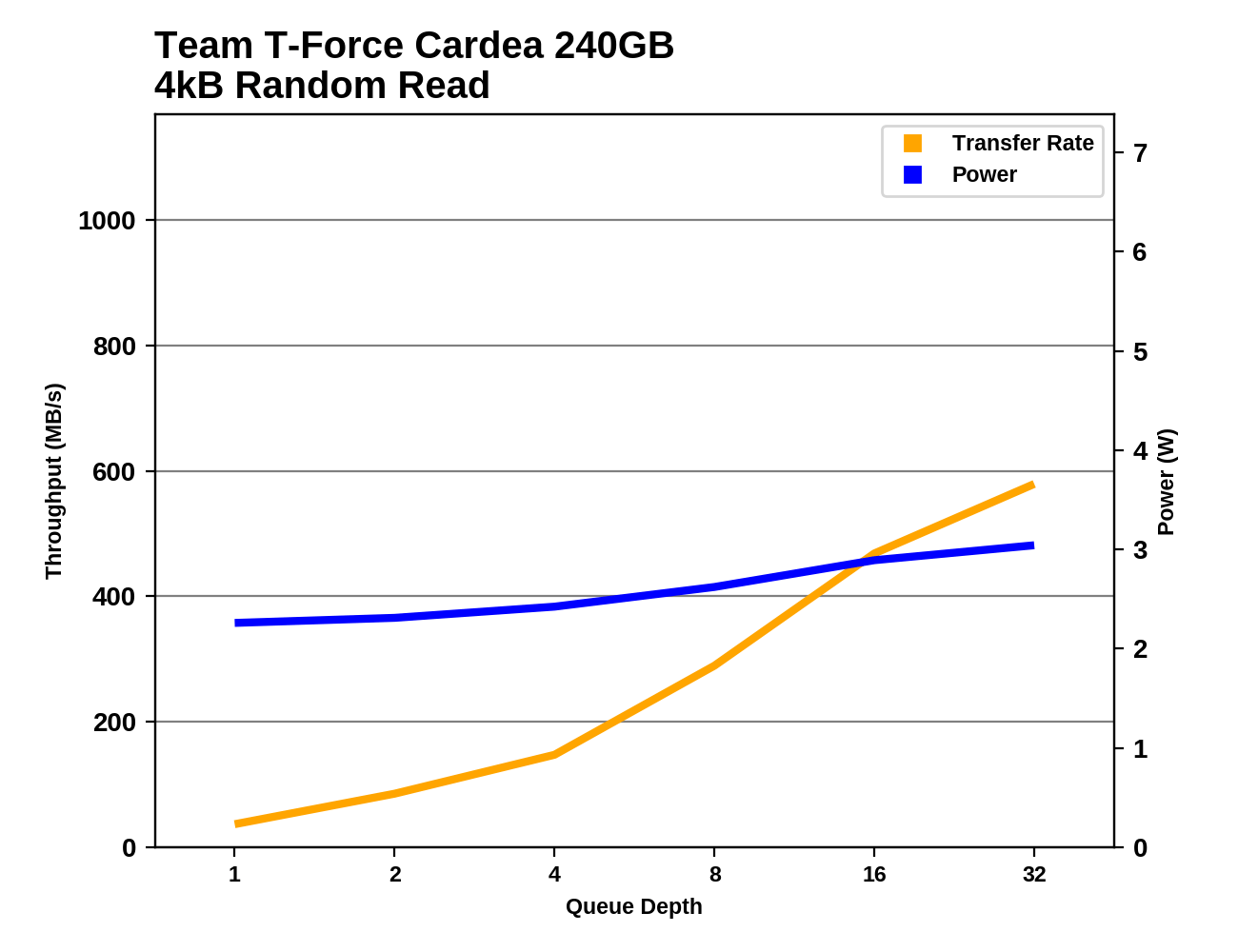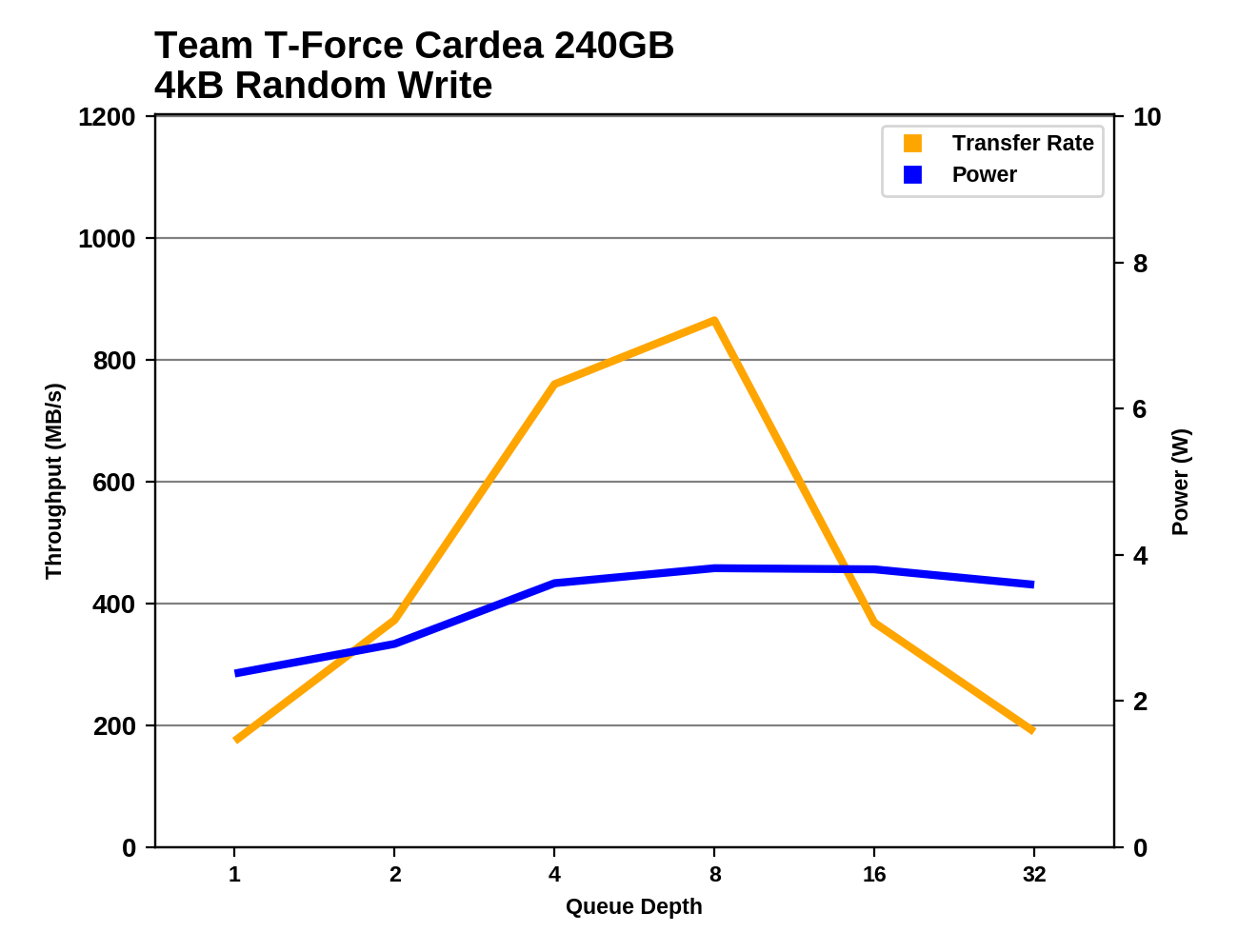The Team Group T-Force Cardea (240GB) SSD Review: Grace Under Write Pressure
by Billy Tallis on September 28, 2017 8:00 AM ESTRandom Read Performance
Our first test of random read performance uses very short bursts of operations issued one at a time with no queuing. The drives are given enough idle time between bursts to yield an overall duty cycle of 20%, so thermal throttling is impossible. Each burst consists of a total of 32MB of 4kB random reads, from a 16GB span of the disk. The total data read is 1GB.

The Phison E7 drives vary widely in their QD1 random read performance. The Team T-Force Cardea isn't the fastest, but it's above average and faster than the SATA drives.
Our sustained random read performance is similar to the random read test from our 2015 test suite: queue depths from 1 to 32 are tested, and the average performance and power efficiency across QD1, QD2 and QD4 are reported as the primary scores. Each queue depth is tested for one minute or 32GB of data transferred, whichever is shorter. After each queue depth is tested, the drive is given up to one minute to cool off so that the higher queue depths are unlikely to be affected by accumulated heat build-up. The individual read operations are again 4kB, and cover a 64GB span of the drive.

On the longer random read test that includes some moderate queue depths, the T-Force Cardea is the fastest Phison E7 drive and slightly faster than the best SATA drive, but clearly slower than most NVMe drives.

In addition to being the fastest Phison E7 drive on the random read test, the T-Force Cardea is also the most power efficient. However, every other M.2 or SATA SSD in this bunch is more efficient than the Phison E7 drives. The Samsung 850 EVO, while slightly slower, delivers twice the efficiency.
 |
|||||||||
At higher queue depths, the random read performance of the Team T-Force Cardea is identical to that of the larger Patriot Hellfire, while the Corsair Neutron NX500 hits the highest speeds out of the Phison E7 drives. The Samsung 960 EVO has a small lead over the T-Force Cardea, and that lead widens with increasing queue depth.
Random Write Performance
Our test of random write burst performance is structured similarly to the random read burst test, but each burst is only 4MB and the total test length is 128MB. The 4kB random write operations are distributed over a 16GB span of the drive, and the operations are issued one at a time with no queuing.

The burst random write performance of the Team T-Force Cardea is second-fastest among the Phison E7 drives, but relatively slow among the wider field of NVMe competition.
As with the sustained random read test, our sustained 4kB random write test runs for up to one minute or 32GB per queue depth, covering a 64GB span of the drive and giving the drive up to 1 minute of idle time between queue depths to allow for write caches to be flushed and for the drive to cool down.

When longer run times and higher queue depths come into play, the T-Force Cardea and other Phison E7 drives look better. The Intel 750's random write performance can't be matched, but the Cardea is well ahead of Samsung's small NVMe drives.

The Team T-Force Cardea and the Patriot Hellfire are tied for first place in random write power efficiency, with a clear lead over the OCZ RD400 and Samsung's drives.
 |
|||||||||
The random write performance of the T-Force Cardea scales very will with increasing queue depth until the drive runs out of spare area and needs to perform garbage collection. The larger Phison E7 drives were able to make it through the entire test without performance falling off, while the smaller Samsung NVMe drives never reached particularly high performance to begin with.










22 Comments
View All Comments
MajGenRelativity - Thursday, September 28, 2017 - link
Yep. Anandtech doesn't have the money to purchase a lot of their own review samples, so it is up to the company to provide them.DanNeely - Thursday, September 28, 2017 - link
More to the point, they can get enough free (donation/loan) hardware to keep their reviewers all busy; why should they buy out of pocket instead. AFAIK most exceptions fall under the category of the reviewer writing about something they bought for personal use.MajGenRelativity - Thursday, September 28, 2017 - link
That also makes senseFlunk - Thursday, September 28, 2017 - link
MyDigitalSSD is a rebrander, they slap their sticker on drives made by an OEM, quite often ADATA. I've taken a look at the model you mentioned and it looks like a PHISON E7 reference design, as such I can't really guess which OEM made it or the real model name.But if you're thinking of buying one, any review of a PHISON E7 reference design should be relevant.
willis936 - Thursday, September 28, 2017 - link
How can anyone compete against samsung in the consumer SSD space?MajGenRelativity - Thursday, September 28, 2017 - link
64 layer NAND and new controllers should allow other companies to do so. The Intel 545s puts up a stiff fightBrokenCrayons - Thursday, September 28, 2017 - link
That's easy, just sell a lower performance product at a competitive price. Certainly Samsung has some good SSDs out there, but the seat-of-the-pants feel between one of their top performing drives and a budget SSD will be small or, in some cases, not noticed outside of benchmarks since the rest of the system becomes a factor in acutal usage. These other competitors can just knock a few percent off the sales price and a lot of people will happily purchase drive that is slower.davidedney123 - Thursday, September 28, 2017 - link
Seriously, who decides "Yeah I'll trust my data to a Team Group Team T-Force Cardea, as it's tuppence cheaper than a drive from Samsung/Intel/Crucial/Some other proper company?Storage is one area I would really not recommend going for off brand tat to save a few dollars.
Billy Tallis - Thursday, September 28, 2017 - link
It's not like any of the important bits are actually designed or built by TeamGroup. This is a Phison drive wearing a Team heatsink. Phison is hardly "off-brand", though they're certainly not the premium brand. They account for a huge portion of the consumer SSD market.davidedney123 - Friday, September 29, 2017 - link
Phison sell them the controller IC, someone else makes the NAND (and the grade will depend on what they are paying the manufacturer for it), but assembly, validation, final testing, and support are all from Frangpai Magic SSD Friend or whatever they are called. My point still stands.